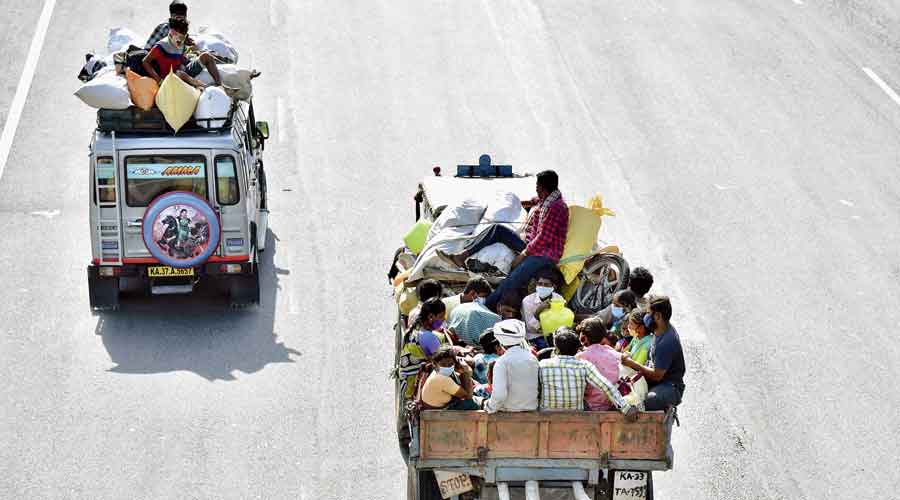The central government hired over 31,000 less employees in 2020-21 than the previous year, exacerbating the country’s growing unemployment rate and belying the Narendra Modi regime’s tall claims on job creation.
Sources said the declining trend of recruitment for central government jobs could be attributed to a cash crunch that has prompted outsourcing of work to private entities at lower rates, reduction in the number of posts, rampant privatisation and closure of PSUs and a sluggish employment generation process. The situation has only been worsened by the pandemic, which has stalled the conduct of exams and slowed down administrative processes.
According to the payroll data on formal employment released by the National Statistical Office (NSO) under the ministry of statistics and programme implementation, the number of new subscribers for the National Pension Scheme (NPS) has come down to 87,423 in 2020-21 from 1,18,843 in 2019-20. (See chart)
Anybody joining a regular central government job has to subscribe to the NPS.
The statistics ministry has been bringing out the employment-related data since April 2018.
Ajeet Sonkar, an unemployed youth in Allahabad, said he was not surprised. “This government is using recruitment exams to earn revenue. It is not interested in giving jobs,” he said.
“Take our example. Around 20 lakh students like me had applied for the Combined Higher Secondary Level Examination of the central Staff Selection Commission in December 2019. We took the objective-type test and the essay-writing exam a year ago. The results are yet to be declared. After the results, we will have to appear for a typing test. Ideally, it takes about one year for the conduct of exams and the announcement of the final results. But this time the process has been dragging on for 18 months and there is still no end in sight,” Sonkar said.
The general category and Other Backward Class candidates have to pay Rs 100 each to appear for the exam, while the process is free for Scheduled Caste and Scheduled Tribe candidates. The successful candidates are recruited to clerical positions.
Sonkar said all the recruitment exams were being delayed over the past five years. The number of posts has also declined, he added. The SSC used to advertise for vacancies to over 15,000 posts for the Combined Graduate Level Exam every year till 2015. The number of posts has declined to about 8,000 a year now.
“We have been protesting on social media against the central government’s delay in recruitment. But the government is not bothered,” Sonkar said. Over 5 million youths had in February stormed Twitter with the hashtag “Modi job do (Modi, give us jobs)”.
Labour economist Prof. Santosh Mehrotra said the drop in the government’s recruitment rate showed that the Centre was contributing to the unemployment situation. The last (2017-18) Periodic Labour Force Survey whose data is available in the public domain found that the unemployment rate was at a four-decade high of 6.1 per cent.
“The government itself is not interested in recruiting for vacant posts. This syndrome is the same with the state governments too. The government does not want to spend on staff,” Mehrotra said.
The Centre has outsourced several jobs to private firms and consultants, whose bill is lower than what it would have had to spend on paying staff salaries. “The central government itself is adding to the unemployment situation,” Mehrotra said.
The government is facing difficulties in paying the salaries of its existing staff, leading to delays. Even doctors and nurses in government hospitals have been paid late, that too amid the pandemic, Mehrotra said.
Prof. K.R. Shyam Sundar, faculty of human resource management at XLRI, Xavier School of Management, Jamshedpur, called the trend of decreasing recruitments “worrisome”.
“While the recruitment rate in 2019-20 witnessed a growth of 7.5 per cent year-on-year, the growth rate for the Covid year 2020-21 over 2019-20 is negative — minus 27 per cent. Notwithstanding the Covid months, the slow pick-up in (NPS) enrolment is a cause of concern,” Sundar said.
Avinash Kumar, a faculty of labour studies at Jawaharlal Nehru University (JNU), said the employees of the central government and its institutions constituted about 18 per cent of the total formal sector staff in the country.
“People put in a lot of effort to get a government job. But the government is not interested in giving jobs. The government raises slogans urging youths to become job creators. Such slogans are jumlas (empty rhetoric). When the government itself is not recruiting for vacant posts, its advice to others to create jobs has no meaning,” Kumar said.
He said public-funded universities had a staff vacancy rate of nearly 40 per cent.


